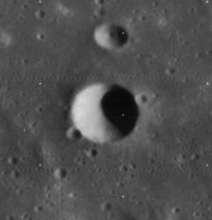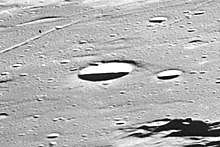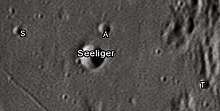Seeliger (crater)
Seeliger is a relatively small lunar impact crater that lies near the southeastern edge of Sinus Medii. It was named after the German astronomer Hugo von Seeliger.[1] This is a circular, cup-shaped feature that has not been appreciably worn by impact erosion. To the southeast is a rille named the Rima Réaumur, following a line to the northwest. In the north is the 110-km-long Rima Oppolzer, which divides the mare where Seeliger is situated from the remainder of the Sinus Medii.
 Lunar Orbiter 4 image | |
| Coordinates | 2.2°S 3.0°E |
|---|---|
| Diameter | 9 km |
| Depth | 1.8 km |
| Colongitude | 357° at sunrise |
| Eponym | Hugo von Seeliger |

Oblique view facing west from Apollo 10
Satellite craters

Seeliger crater and its satellite craters taken from Earth in 2012 at the University of Hertfordshire's Bayfordbury Observatory with the telescopes Meade LX200 14" and Lumenera Skynyx 2-1
By convention these features are identified on lunar maps by placing the letter on the side of the crater midpoint that is closest to Seeliger.
| Seeliger | Latitude | Longitude | Diameter |
|---|---|---|---|
| A | 1.8° S | 3.0° E | 4 km |
| S | 2.1° S | 2.1° E | 4 km |
| T | 2.2° S | 4.4° E | 4 km |
gollark: My laptop lets me do convoluted compose key sequences for Greek, but I'm on a phone.
gollark: Anyway, modern compression algorithms are cool and good, so I'd expect a compression ratio around 3 on big enough chunks of message data.
gollark: I should install an ancient Greek keyboard again.
gollark: If you paste your token into discord by mistake, it replaces it with \*s, you know.
gollark: I assumed 100 bytes per message (actual string, plus timestamp, user ID, channel ID, SQLite overhead) and multiplied by 500k, and I think 50MB or so is a tractable amount to store. Although I do still want a packed representation.
References
- "Seeliger (crater)". Gazetteer of Planetary Nomenclature. USGS Astrogeology Research Program.
- Andersson, L. E.; Whitaker, E. A. (1982). NASA Catalogue of Lunar Nomenclature. NASA RP-1097.CS1 maint: ref=harv (link)
- Bussey, B.; Spudis, P. (2004). The Clementine Atlas of the Moon. New York: Cambridge University Press. ISBN 978-0-521-81528-4.CS1 maint: ref=harv (link)
- Cocks, Elijah E.; Cocks, Josiah C. (1995). Who's Who on the Moon: A Biographical Dictionary of Lunar Nomenclature. Tudor Publishers. ISBN 978-0-936389-27-1.CS1 maint: ref=harv (link)
- McDowell, Jonathan (July 15, 2007). "Lunar Nomenclature". Jonathan's Space Report. Retrieved 2007-10-24.CS1 maint: ref=harv (link)
- Menzel, D. H.; Minnaert, M.; Levin, B.; Dollfus, A.; Bell, B. (1971). "Report on Lunar Nomenclature by the Working Group of Commission 17 of the IAU". Space Science Reviews. 12 (2): 136–186. Bibcode:1971SSRv...12..136M. doi:10.1007/BF00171763.CS1 maint: ref=harv (link)
- Moore, Patrick (2001). On the Moon. Sterling Publishing Co. ISBN 978-0-304-35469-6.CS1 maint: ref=harv (link)
- Price, Fred W. (1988). The Moon Observer's Handbook. Cambridge University Press. ISBN 978-0-521-33500-3.CS1 maint: ref=harv (link)
- Rükl, Antonín (1990). Atlas of the Moon. Kalmbach Books. ISBN 978-0-913135-17-4.CS1 maint: ref=harv (link)
- Webb, Rev. T. W. (1962). Celestial Objects for Common Telescopes (6th revised ed.). Dover. ISBN 978-0-486-20917-3.CS1 maint: ref=harv (link)
- Whitaker, Ewen A. (1999). Mapping and Naming the Moon. Cambridge University Press. ISBN 978-0-521-62248-6.CS1 maint: ref=harv (link)
- Wlasuk, Peter T. (2000). Observing the Moon. Springer. ISBN 978-1-85233-193-1.CS1 maint: ref=harv (link)
This article is issued from Wikipedia. The text is licensed under Creative Commons - Attribution - Sharealike. Additional terms may apply for the media files.